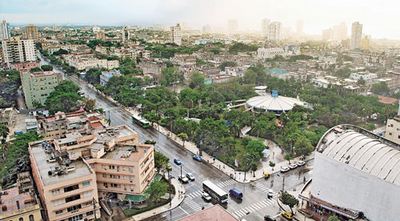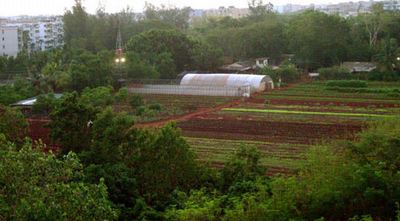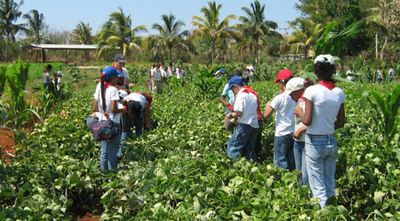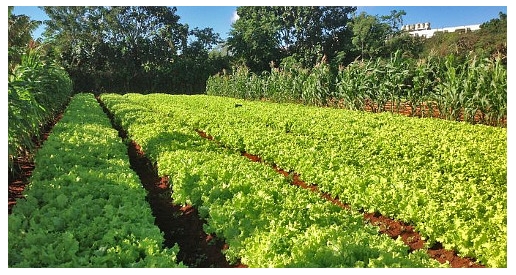CUBA - LEADER IN SUSTAINABLE URBAN AND PERI-URBAN AGRICULTURE
“Urban and Peri-urban Agriculture”, or UPA, are key components of robust and resilient urban food systems that are now beginning to provide food for people in several parts of the world, while also building the greener, more resilient and sustainable cities of the future. Cuban developed ‘organoponics’ is leading the worldwide transition to sustainable agriculture that produces “more with less”.
Concern over rising fuel and fertilizer prices, growing competition for land and water, and the environmental impact of agrochemicals has made a new paradigm of intensive crop production essential for the future, one that is both highly productive and sustainable. This has been recognized by the Food and Agriculture Organisation of the United Nations, who advocate a “Save and Grow” model of agriculture using an “ecosystem approach” that draws on nature’s contributions to crop productivity.
Such a model has already been long developed by the Cubans, who serve as leaders and models for sustainable urban and peri-urban agriculture throughout the world.
Havana
The collapse of the Soviet Union in 1991 deprived Cuba of its main trading partner and source of fossil fuel. That ushered in what Cubans call the período especial, an extended economic crisis which led to food rationing and rising rates of malnutrition. With agriculture affected by shortages of fuel and of two key petroleum derivatives – mineral fertilizer and pesticide – Havana residents began planting food crops wherever space was available. At first, yields were low, owing to lack of farming experience and inputs. But with strong government support, urban agriculture was rapidly transformed from a spontaneous response to food insecurity to a national priority. In the process, Havana has added a new word, organoponics , to the urban agriculture vocabulary, and has become a pioneer in a worldwide transition to sustainable agriculture that produces “more with less”.

Intensive vegetable production in Havana began in the 1800s, when Chinese immigrants started market gardens on the city’s outskirts. But the foundation of today’s flourishing urban and peri-urban agriculture movement can be traced to a precise date: 27 December 1987, when the Central Committee of Cuba’s Communist Party called for action nationwide to promote intensive horticulture, using a technology known as “organoponics”.
Organopónicos is a Cuban invention. The term was coined to distinguish it from other intensive, high- yielding horticulture production systems, such as hydroponics, which grows plants on water and inert substrates that have been enriched with mineral nutrients. While Havana’s urban farmers have experimented with hydroponics, that technology depends on a reliable supply of chemical inputs.
The Cubans called their solution organoponics because it uses an organic substrate, obtained from crop residues, household wastes and animal manure.
With the onset of the período especial, organoponic gardens proved ideal for growing crops on poor soils in small urban spaces. A typical organoponic garden is started by making furrows in the soil, then lining the rows with protective barriers of wood, stone, bricks or concrete. The soil quality is gradually improved through the incorporation of organic matter; as organic content increases, so do the levels of soil nutrients and moisture (and the height of the bed).
Organopónicos – the term applies to both the technology and the garden – can be applied on building sites, vacant lots and roadsides, and arranged in terraces on sloping land. Soil can be tailored, using specific mixtures, to specific crops. If the soil is affected by nematodes or fungi, the entire substrate can be replaced. If necessary, the gardens can be disassembled and relocated.
With drip irrigation, regular addition of compost and good horticultural practices – such as the use of well-adapted varieties, mixed cropping, crop rotation and integrated pest management – the raised beds can produce vegetables all year round, and achieve yields of up to 20 kg per sq m.

In 2013, Havana counted 97 high-yielding organoponics, which produce vegetables such as lettuce, chard, radish, beets, beans, cucumber, tomatoes, spinach and peppers. Among the best known is Vivero Alamar, which was created on abandoned wasteland 8 km east of the city centre in 1997. Run by a cooperative with 180 members, Alamar’s gardens produce some 300 tonnes of organic vegetables a year.
Agricultural production in Havana is implemented under two national programmes, one for urban and one for peri-urban areas. It is strongly encouraged by the Cuban Government, which created the Havana Provincial Office of Agriculture, seven provincial technical departments and 15 municipal offices to assist the sector. The government has also introduced measures to grant vacant land free of charge for agriculture and to encourage the participation of women and youth.
Crop and animal production is recognized as a legitimate land use in the city’s strategic plan, which allows agriculture in areas where construction is not foreseen, while its Land and Urban Management Scheme of 2013 sees peripheral areas as highly suitable for agriculture. UPA is supported by a Technical Advisory Board, representing 11 agricultural research institutes, by a network of agricultural supply stores, municipal seed farms, composting units, veterinary clinics and centres for the reproduction of biological pest control agents, and by the city’s College of Urban and Suburban Agriculture, which coordinates the training of producers and technicians, and helps to introduce new technologies, crop varieties and animal breeds.
Although organopónicos have become emblematic of agriculture in Havana, the city has developed other high-yielding production systems. It has 318 intensive gardens planted directly in the soil, and 38 ha of semi-protected gardens under awnings in soil enriched with vermicompost.
The city’s urban and peri-urban agriculture sector includes five agricultural enterprises, which manage some 700 crop farms, 170 cattle farms and 27 tree production units, two provincial companies specializing in pig and livestock production, 29 agricultural cooperatives, and 91 credit and service cooperatives that grow flowers and vegetables and raise small animals.
The total area under agriculture in Havana is estimated at some 35 900 ha, or half the area of Havana Province. Production in 2012 included 63 000 tonnes of vegetables, 20 000 tonnes of fruit, 10 000 tonnes of roots and tubers, 10.5 million litres of cow, buffalo and goat milk and 1 700 tonnes of meat.
In addition, 89 000 backyards and 5 100 plots of less than 800 sq m are used by families in the city to grow fruit, vegetables and condiments and to raise small animals, such as poultry and guinea pigs, for household consumption. In densely populated areas, food is produced in containers on rooftops and balconies. In all, some 90 000 Havana residents are engaged in some form of agriculture.
Product marketing is based on direct exchange between the producer and the consumer. Fresh produce is marketed through a wide range of outlets, including sales points located within 5 km of production units and throughout Havana’s urban neighbourhoods. In 2013, sales amounted to 58 000 tonnes. Almost half of that – 26 500 tonnes – was sold to the public through local sales points, while state markets and fairs handled 21 000 tonnes.
A further 6 770 tonnes were supplied through daily deliveries to almost 300 000 people in “priority destinations”, such as schools, maternity homes, public health centres, hospitals and other institutions in the city. Many farmers, especially in the cooperative sector, market processed products, such as spices, and processed meats, fruit and vegetables, and have supply contracts with the tourist industry, which accounted for 3 500 tonnes of sales made in 2013.
 The holistic approach to agriculture in Havana, and in Cuba generally, has been shaped by the need to produce high yields with minimal use of external inputs, especially agrochemicals derived from fossil fuel. It has been said that Cuba was the first country to experience a “peak oil” crisis, one that will eventually affect food production worldwide.
The holistic approach to agriculture in Havana, and in Cuba generally, has been shaped by the need to produce high yields with minimal use of external inputs, especially agrochemicals derived from fossil fuel. It has been said that Cuba was the first country to experience a “peak oil” crisis, one that will eventually affect food production worldwide.
Havana serves as a good example for countries desperately trying to feed their people. Most of the agriculture in the city is fully organic – the use of agrochemicals in urban gardens is prohibited by law and is also impractical, given the limited quantities available. Because a reliable supply of soil nutrients is essential for improving garden substrate and maintaining high yields, the UPA programme produces compost, green manure, vermicompost, bio-fertilizer and liquid fertilizers, links gardeners to sources of manure, such as livestock production units, and identifies other local sources of organic matter, including crop and household wastes and agro-industrial residues, such as coffee husks and sawdust.
In order to control insect pests and diseases, producers are trained to analyse phytosanitary problems and to respond not by attacking the symptoms but by removing the cause – for example, improving drainage to treat mould. They use biopesticides and biological control agents supplied by the city’s six centres for the production of natural pathogens, predators and parasites of insect pests.
The agro-ecological approach offers considerable cost benefits. The UPA programme has calculated that producing 1 million tonnes of vegetables under conventional agriculture requires around US$40 million worth of mineral fertilizer and US$2.8 million worth of pesticide. The amount of organic fertilizer required for the same level of production is around 1 million cubic m, and the main cost is the diesel fuel needed to transport it an average distance of 10 km to the farmer’s field.
The fuel cost per tonne of organic vegetables is US$0.55, compared to a fertilizer cost of US$40 per tonne under conventional agriculture, representing a total saving of US$39.5 million. The cost of pest control is also reduced – from US$2.8 million to US$300 000 – by using biological control agents and biopesticides.
Other savings can be achieved through local production of good quality seed which, under intensive production, can improve yields by 30 percent. Given the high cost of imported seed, the UPA programme has established 10 local vegetable seed farms, which supply 40 percent of the lettuce seed and 20 percent of the Chinese chard sown in Havana’s urban gardens. (Nationwide, municipal seed farms produce annually 17.6 tonnes of seed of 22 species and 40 varieties). Havana also has 28 units that supply high- quality plant seedlings – mainly of tomato, cabbage, lettuce, cucumber, peppers and onions – in root balls, ready for transplanting in the field.
Seed, soil improvers, vermicompost and biological pest control agents, along with tools and veterinary supplies, are sold through 52 agricultural stores, which are located in all 15 municipalities. The stores also provide technical services, advice and training to the city’s farmers. All urban farmers have access to agricultural insurance, and to production loans from Havana’s Banco Metropolitano.
Havana has set guidelines for agricultural development in the rest of Cuba, and not only in towns and cities. Its approach has been adopted as a management model by the national Ministry of Agriculture, which promotes a mix of “technical-industrial” and agro-ecological production in rural areas.
Innovations such as organoponics, along with technologies for the production of bio-fertilizers and the processing and conservation of seed, have been transferred abroad through technical assistance to urba n agriculture programmes in more than 10 Latin American countries, including Colombia, Mexico and Venezuela and other countries of the Caribbean. The Ministry of Agriculture’s national Institute of Fundamental Research in Tropical Agriculture (INIFAT) has developed a three-year master’s degree course in urban and peri-urban agriculture that has attracted students from Europe and Japan.
n agriculture programmes in more than 10 Latin American countries, including Colombia, Mexico and Venezuela and other countries of the Caribbean. The Ministry of Agriculture’s national Institute of Fundamental Research in Tropical Agriculture (INIFAT) has developed a three-year master’s degree course in urban and peri-urban agriculture that has attracted students from Europe and Japan.
One key lesson from the past 20 years of experience in Havana is that, to be productive and sustainable, urban agriculture must adapt to physical urban conditions and to local potentials and resources. Adaptability will be required again as Cuba’s economy improves and new priorities emerge in its city planning. Since the dark days of the período especial, per capita GDP in Cuba has grown by almost 80 percent – one of the strongest performances in Latin America – thanks to economic reforms, growth in revenue from tourism and exports, and, most recently, a boom in the construction sector.
While Havana’s new Land and Urban Management Scheme favours agriculture in peri-urban areas, it designates free spaces in the intermediate zone for industrial and service investments, and those in central areas for high technology enterprises and major hotels.
Many of the city’s present farming areas will be affected by an urban reorganization plan, which calls for the removal of temporary plots in central Havana, a reduction in intensive livestock production in areas above the city’s aquifer, and the removal of pig farms from urban areas.
However, agriculture has left an indelible mark on Havana’s landscape and its proven benefits – food security, improved child nutrition, employment and the revival of social values and solidarity – are recognized by both the government and society at large. Among the Havana UPA programme’s strategic priorities are to realize the full productive potential of urban agriculture and to accelerate the organization of urban food producers.
To achieve that, the programme plans to increase the output of biofertilizer and seed, strengthen support services, and build the capacities of producers in the management of infrastructure, the use of water- saving technologies and rainwater harvesting, and integrated pest management.
Meanwhile, Cuba is preparing the next generation of urban and peri-urban farmers. The country has some 3000 study circles, where agricultural technicians and producers encourage children and youth to take up agriculture and learn more about agro-ecological production practices. In Havana, students are invited to take part in local agricultural activities, and schools use UPA as a practical example when teaching simple arithmetic, participatory production and social relations.
Not only Havana, but nationwide
Urban and peri-urban agriculture in Havana has evolved along with Cuba’s national programme for food production in urban areas. During the economic crisis of the 1990s, the focus was on developing organoponic and intensive gardens in empty or underutilized city spaces. I n 1997, what had been until then a popular participatory activity was institutionalized, with appropriate legislation, to become the Movimiento de agricultura urbana. In 2009, the government created a complementary

programme for agricultura suburbana, which seeks to transfer the “extremely positive experiences” of urban agriculture to the peripheries of Cuba’s towns and cities.
Both programmes aim at achieving local food self-sufficiency through “food production in the barrio, by the barrio and for the barrio”. Their basic principles are agro-ecological production, local-level sustainability, continuous technological innovation, and producers’ ownership of what they produce. They are expected to use simple technologies and minimal resources in order to increase food production and reduce dependence on food imports.
In Cuba as a whole, agriculture is now practised by some 40 000 urban workers on an area estimated at 33 500 ha. It includes 145 000 small farm plots, 385 000 backyard gardens, 6 400 intensive gardens and 4 000 high-yielding organopónicos.
A feature of UPA in Cuba is the high degree of local autonomy, which is seen as a key to ensuring food security. Cuba’s strategy is to promote agriculture in small, local areas with a large number of producers who grow food for their own consumption and to meet the food needs of their neighbourhood. Each territory acts autonomously in producing inputs such as seed, animal feed, organic fertilizers and biological agents for pest control.
Overall coordination of UPA is carried out by the National Urban and Suburban Agriculture Group, under the direction of the Institute of Fundamental Research in Tropical Agriculture. The group brings together representatives of the Ministry of Agriculture and six other ministries, as well as those of 16 scientific institutions and 53 urban and suburban agriculture subprogrammes.

